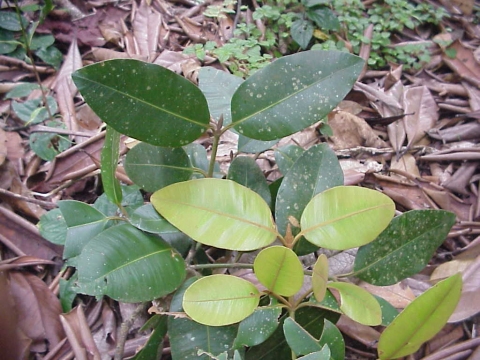Calophyllum papuanum
Lauterb.
Calophyllaceae
Common Name:

Leaves
Photograph by: Unknown
© 2005 National and regional Governments of Papua New Guinea; and the State Government of New South Wales

Leaves
Photograph by: Unknown
© 2005 National and regional Governments of Papua New Guinea; and the State Government of New South Wales

Trunk
Photograph by: Unknown
© 2005 National and regional Governments of Papua New Guinea; and the State Government of New South Wales

Trunk with slash removed to show the wood
Photograph by: Unknown
© 2005 National and regional Governments of Papua New Guinea; and the State Government of New South Wales
General Information
Calophyllum papuanum is an evergreen tree that can be as small as 5 metres, but is more commonly from 16 - 40 metres tall. The crown is conical at first, but becoming irregular and spreading with age. The straight bole, which sometimes has spurs or buttresses up to 3 metres tall, is unbranched for up to 20 metres and up to 92cm in diameter[
388- Title
- Guide to the Trees of Papua New Guinea
- Publication
-
- Author
- Conn. B.J. & Damas. K.Q.
- Website
- http://www.pngplants.org/PNGtrees/
- Publisher
-
- Year
- 0
- ISBN
-
- Description
- An Internet site giving good descriptions of the trees of Papua New Guinea.
,
532- Title
- Journal of the Arnold Arboretum Vol 61
- Publication
-
- Author
-
- Website
- http://www.biodiversitylibrary.org
- Publisher
- Harvard University
- Year
- 1980
- ISBN
- 0004-2625
- Description
- A treatment of the Asian species of Colophyllum is just one of the articles in this publication. It can be downloaded from the Internet.
].
A major source of timber, the tree is harvested from the wild for its wood, which is exported in quantity and also used locally.
The tree is classified as 'Least Concern' in the IUCN Red List of Threatened Species(2011)[
338- Title
- IUCN Red List of Threatened Species
- Publication
-
- Author
-
- Website
- http://www.iucnredlist.org/
- Publisher
-
- Year
- 0
- ISBN
-
- Description
- A list of plants under threat and facing possible extinction, usually with brief details of the threats and information on habitat.
].
Known Hazards
None known
Botanical References
532- Title
- Journal of the Arnold Arboretum Vol 61
- Publication
-
- Author
-
- Website
- http://www.biodiversitylibrary.org
- Publisher
- Harvard University
- Year
- 1980
- ISBN
- 0004-2625
- Description
- A treatment of the Asian species of Colophyllum is just one of the articles in this publication. It can be downloaded from the Internet.
Range
Southeast Asia - Indonesia from the Moluccas to New Guinea.
Habitat
Usually a canopy tree of colline or montane forest that is often dominated by Fagaceae; rarely in more or less swampy forest or depleted Agathis forest over limestone with thick clay cover; at elevations from near sea level to 1,830 metres[
532- Title
- Journal of the Arnold Arboretum Vol 61
- Publication
-
- Author
-
- Website
- http://www.biodiversitylibrary.org
- Publisher
- Harvard University
- Year
- 1980
- ISBN
- 0004-2625
- Description
- A treatment of the Asian species of Colophyllum is just one of the articles in this publication. It can be downloaded from the Internet.
].
Properties
| Conservation Status | Least Concern |
| Other Uses Rating |      |
| Habit | Evergreen Tree |
| Height | 30.00 m |
| Cultivation Status | Wild |
Cultivation Details
Not known
Edible Uses
None known
Medicinal
None known
Other Uses
The heartwood is dark red to brown red or pinkish brown with darker veins; it is clearly demarcated from the 5 - 10cm wide band of sapwood. The grain is interlocked; the texture is medium. The wood is moderately heavy; moderately hard; moderately durable being resistant to dry wood borers and moderately resistant to fungi and termites. It is somewhat slow to season, with a high risk of distortion and a slight risk of checking; once dry it is stable in service. It can be worked with ordinary tools, though there is a tendency to wooliness and filling is recommended in order to obtain a good finish; nailing and screwing are good, but pre-boring is required; gluing is correct for interior use. It is used for interior purposes such as flooring, furniture, boxes and crates, formwork, sliced veneer, panelling, stairs, joinery and veneer. It is also suitable for exterior applications such as ship building, wood frame houses, joinery and heavy carpentry. The wood can also be used for high class furniture if the grain is not highly interlocked[
,
848- Title
- Tropix 7
- Publication
-
- Author
-
- Website
- http://tropix.cirad.fr/en
- Publisher
- CIRAD
- Year
- 0
- ISBN
-
- Description
- An on-line guide to the timbers of 245 species of trees.
].
Propagation
Seed -
If you have any useful information about this plant, please leave a comment. Comments have to be approved before they are shown here.




 Useful Tropical Plants Database 2014 by
Ken Fern,
web interface by
Ajna Fern
with help from
Richard Morris.
Useful Tropical Plants Database 2014 by
Ken Fern,
web interface by
Ajna Fern
with help from
Richard Morris.